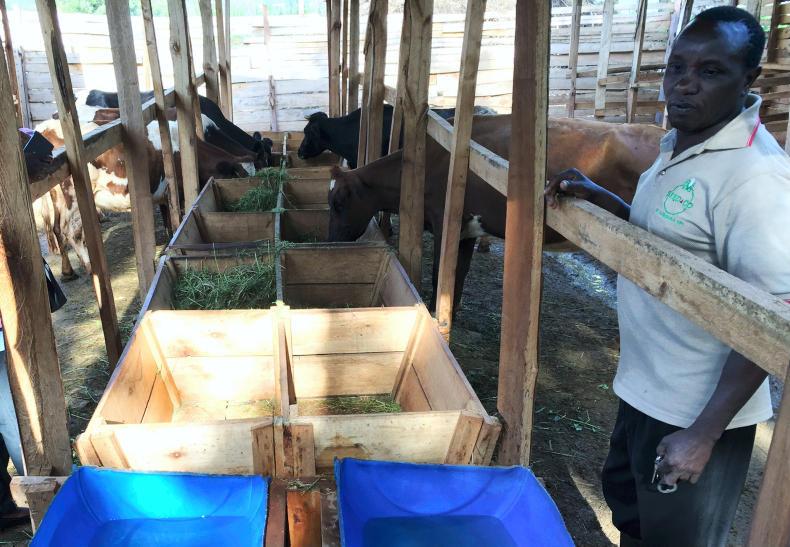After a few minutes visiting Meru Farm outside the Kenyan town of Kitale, you quickly forget the surrounding banana trees and clear blue skies. Its owner, Amos Njuguna, speaks just like any efficient Irish dairy farmer: his objectives are to improve the feed-growing capacity of his 10-acre farm and the genetics of his five cows, ultimately to get the maximum milk from his land at the lowest possible cost.
The farm’s centrepiece is the housing unit Amos built six months ago with timber from trees grown on his farm. The design, with the trough at the centre of the concrete slab and roofed stalls either side with some open walking space in between, was part of his plan to “intensify the number of animals without going too big”.
The cows are housed all year round: “There is not much to eat out there, and they pick up diseases from others,” Amos told the Irish Farmers Journal in reference to the common grazing of cattle in the ditches along public roads around here.

There is a manual one-cow milking parlour immediately inside the entrance (pictured above), and Amos is considering buying a milking machine. But his priority for now is to add a calf pen for the cows due to calve next month.
“I will build timber slats to keep the calves dry and avoid pneumonia,” he said. This will be modelled on the sheep pen suspended on stilts and timber slats, where Amos has just started to keep two ewes and one ram in a lamb diversification venture.

The surrounding fields are planted in fodder crops. Roughage comes from a combination of maize, which Amos cuts for silage, and Napier and Rhodes tropical grasses (pictured) for zero-grazing. He also makes a dry feed mix with hay and maize. “It has high dry matter and I add molasses and fodder yeast to make it more palatable,” he said.
But Amos’s real challenge is to find the perfect legume for his farm: “The problem farmers have here is that protein is very expensive,” he said. Fish meal is commonly used, at a typical cost of €1.15/day for a lactating cow.
After growing his own soybeans last year, Amos planted two types of lupine this year.
“I’ll probably go for a mix of lupine and soybean,” he said. Another source of protein is desmodium, a creeper planted with the tall grass crops and zero-grazed at the same time.
Two full-time staff
Amos employs two full-time staff, including his son. He also hires casual workers by the day for weeding and other labour-intensive jobs, and contractors for tractor work such as planting and spraying.

The only machine on the farm is a feed chopper (pictured) used to cut up the crops harvested manually. Most fertilisation comes from a compost of the farm’s cattle manure and plant waste.
As a member of the local co-op, Amos brings his milk daily to the communal bulk tank. Brookside Dairies, Kenya’s largest milk processor, collects it from there. The farmgate price is 29c/l, an improved rate agreed by Brookside to grow its supply from this region as part of the Livelihoods project.
I want to become a learning centre for other farmers
The other partners in the project are Livelihoods Fund, an environmental investment fund formed by European corporations, and VI Agroforestry, an organisation helping smallholder farmers improve their business and environmental efficiency. Amos is one of the more advanced participant in the project.
 Amos’s plan is to grow his herd to eight cows and become a breeder to sell in-calf heifers from his herd. “My cows are not pedigree, but I’m going to improve them,” he said, using AI to increase the genetic merit of his Ayrshire and Friesian cows. Each cow’s maximum yield at peak time is currently 16l/day. Amos wants to multiply this by four.
Amos’s plan is to grow his herd to eight cows and become a breeder to sell in-calf heifers from his herd. “My cows are not pedigree, but I’m going to improve them,” he said, using AI to increase the genetic merit of his Ayrshire and Friesian cows. Each cow’s maximum yield at peak time is currently 16l/day. Amos wants to multiply this by four.
“I want to become a learning centre for other farmers, bring members of my group here and say: ‘This is the way to go’,” he added.
Read more about the Livelihoods project in the Irish Farmers Journal in the coming weeks.
Watch: milking 660 cows with a mobile parlour in Chile
Farming issues fuel tense Kenyan election campaign
 Reporting supported by the Simon Cumbers Media Fund.
Reporting supported by the Simon Cumbers Media Fund.
